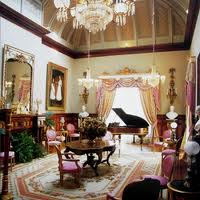The
Calhoun Mansion
There isn't another house, cottage, mansion, villa,
or other inhabitable space on the Charleston peninsula that can
compare to the Calhoun Mansion in Charleston, South Carolina, that
sits with a magnificent Italianate style, the biggest in the city,
with 35 rooms, a 90 foot cupola, three levels of piazzas, 75 foot
high domed stair hall ceiling, a grand ballroom, khoi ponds,
Japanese water gardens, 35 fireplaces, a private elevator, elegant
chandeliers and more outstanding surprises that are sure to pique
your imagination. The house, or mansion, is nothing less than a
fabulous testament to the craftsmanship of the period, creating such
magnificent results with just ordinary hand tools, and the most
rudimentary of those at best. The mansion is a creative delight,
filled with decorative splendor, exquisite works of art and
beautiful works of art, and fascinating architectural spaces. The
home was constructed for George W. Williams at a staggering cost of
$200,000, and the lot cost $40,000 but in Confederate dollars, all
designed by William P. Russel. Taking up 24,000 square feet of
spaces, it has fourteen foot ceilings, excellent plaster and wood
moldings and a music room that has a 45 foot covered glass skylight.
The decorative painting is unmatched, with fantastic lighting
designed and installed by Louis Comfort Tiffany around the turn of
the century; and has a grand entry hall that is 14 feet high by 14
feet wide and 65 feet long. The house and property have a
distinguished history, since George Washington would visit part of
the property that had belonged to the Lowndes House, where the
governor lived and hosted George three times in May of 1791. After
Williams passed on in 1903, the house would go through various
owners and uses, slowly deteriorating until it would be condemned in
1972; but it would be saved by a local native that would spend the
next twenty five years and $5 million to restore it.
|

